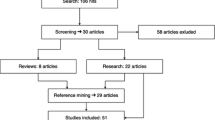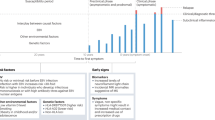Abstract
Viral infections are probably involved in the pathogenesis of multiple sclerosis (MS). A recent cohort study in the Gothenburg population revealed no change in MS incidence associated with the introduction of the Swedish measles, mumps and rubella vaccination programmes. The aim of the present study was to clarify whether these infections or vaccinations, and two other infections, varicella and infectious mononucleosis, influence MS risk. We performed a population-based case–control study in Gothenburg that included 509 MS cases and 2,067 controls, born 1959–1986. Data on infections and vaccinations were obtained from questionnaires and from child health and school health records. We found no significant associations between measles, mumps, rubella or varicella and MS risk. These results were consistent between the two source materials. Infectious mononucleosis was associated with significantly higher MS risk (odds ratio 2.03, 95% CI 1.52–2.73). Overall, there was no significant association between measles-mumps-rubella (MMR) vaccination and MS risk, while those MMR vaccinated before age ten only were at significantly higher MS risk (odds ratio 4.92, 95% CI 1.97–12.20). Those MMR vaccinated both before and after age ten had intermediate MS risk. Infection with measles, mumps, rubella and varicella did not influence MS risk in contrast to infectious mononucleosis which conferred doubled MS risk. The association with ‘early’ MMR vaccination only was an isolated finding, limited by a small number of subjects and multiple testing. Most likely this was a chance finding. Future studies could investigate it on an a priori basis.


Similar content being viewed by others
Abbreviations
- CI:
-
Confidence interval
- CIS:
-
Clinically isolated syndrome
- CSF:
-
Cerebrospinal fluid
- EBV:
-
Epstein–Barr virus
- MMR:
-
Measles-mumps-rubella
- MRI:
-
Magnetic resonance imaging
- MS:
-
Multiple sclerosis
- OR:
-
Odds ratio
References
Dean G, Kurtzke JF. On the risk of multiple sclerosis according to age at immigration to South Africa. Br Med J. 1971;3(5777):725–9.
Kurtzke JF, Beebe GW, Norman JE Jr. Epidemiology of multiple sclerosis in US veterans: III. Migration and the risk of MS. Neurology. 1985;35(5):672–8.
Elian M, Nightingale S, Dean G. Multiple sclerosis among United Kingdom-born children of immigrants from the Indian subcontinent, Africa and the West Indies. J Neurol Neurosurg Psychiatry. 1990;53(10):906–11.
Sullivan CB, Visscher BR, Detels R. Multiple sclerosis and age at exposure to childhood diseases and animals: cases and their friends. Neurology. 1984;34(9):1144–8.
Compston DA, Vakarelis BN, Paul E, McDonald WI, Batchelor JR, Mims CA. Viral infection in patients with multiple sclerosis and HLA-DR matched controls. Brain. 1986;109(Pt 2):325–44.
Bachmann S, Kesselring J. Multiple sclerosis and infectious childhood diseases. Neuroepidemiology. 1998;17(3):154–60.
Hernan MA, Zhang SM, Lipworth L, Olek MJ, Ascherio A. Multiple sclerosis and age at infection with common viruses. Epidemiology. 2001;12(3):301–6.
Vandvik B, Norrby E, Nordal HJ. Optic neuritis: local synthesis in the central nervous system of oligoclonal antibodies to measles, mumps, rubella, and herpes simplex viruses. Acta Neurol Scand. 1979;60(4):204–13.
Salmi A, Reunanen M, Ilonen J, Panelius M. Intrathecal antibody synthesis to virus antigens in multiple sclerosis. Clin Exp Immunol. 1983;52(2):241–9.
Bray PF, Luka J, Culp KW, Schlight JP. Antibodies against Epstein–Barr nuclear antigen (EBNA) in multiple sclerosis CSF, and two pentapeptide sequence identities between EBNA and myelin basic protein. Neurology. 1992;42(9):1798–804.
Frederiksen JL, Sindic CJ. Intrathecal synthesis of virus-specific oligoclonal IgG, and of free kappa and free lambda oligoclonal bands in acute monosymptomatic optic neuritis. Comparison with brain MRI. Mult Scler. 1998;4(1):22–6.
Reiber H, Ungefehr S, Jacobi C. The intrathecal, polyspecific and oligoclonal immune response in multiple sclerosis. Mult Scler. 1998;4(3):111–7.
Rand KH, Houck H, Denslow ND, Heilman KM. Epstein–Barr virus nuclear antigen-1 (EBNA-1) associated oligoclonal bands in patients with multiple sclerosis. J Neurol Sci. 2000;173(1):32–9.
Bednarova J, Stourac P, Adam P. Relevance of immunological variables in neuroborreliosis and multiple sclerosis. Acta Neurol Scand. 2005;112(2):97–102.
Petereit HF, Reske D. Expansion of antibody reactivity in the cerebrospinal fluid of multiple sclerosis patients-follow-up and clinical implications. Cerebrospinal Fluid Res. 2005;2:3.
Owens GP, Bennett JL, Gilden DH, Burgoon MP. The B cell response in multiple sclerosis. Neurol Res. 2006;28(3):236–44.
Poskanzer DC, Sever JL, Sheridan JL, Prenney LB. Multiple sclerosis in the Orkney and Shetland Islands. IV: viral antibody titres and viral infections. J Epidemiol Community Health. 1980;34(4):258–64.
Sundstrom P, Juto P, Wadell G, Hallmans G, Svenningsson A, Nystrom L, et al. An altered immune response to Epstein–Barr virus in multiple sclerosis: a prospective study. Neurology. 2004;62(12):2277–82.
Hafler DA, Compston A, Sawcer S, Lander ES, Daly MJ, De Jager PL, et al. Risk alleles for multiple sclerosis identified by a genomewide study. N Engl J Med. 2007;357(9):851–62.
Goverman J, Woods A, Larson L, Weiner LP, Hood L, Zaller DM. Transgenic mice that express a myelin basic protein-specific T cell receptor develop spontaneous autoimmunity. Cell. 1993;72(4):551–60.
Bjorvatn B, Skoldenberg B. [Meningitis in mumps and orchitis in Stockholm during 1955–1976—an epidemiological background for a vaccination policy] In Swedish. Lakartidningen. 1978;75(23):2295–8.
Christenson B, Bottiger M. Changes of the immunological patterns against measles, mumps and rubella. A vaccination programme studied 3 to 7 years after the introduction of a two-dose schedule. Vaccine. 1991;9(5):326–9.
Taranger J. Vaccination programme for eradication of measles, mumps, and rubella. Lancet. 1982;1(8277):915–6.
Strom J. Social development and declining incidence of some common epidemic diseases in children. A study of the incidence in different age groups in Stockholm. Acta Paediatr Scand. 1967;56(2):159–63.
Strom J. [On the incidence of common epidemics of infectious diseases in the light of conditions in Stockholm.] In Swedish. Soc Med Tidskr. 1959;36:347–54.
Lundstrom R, Svedmyr A, Hagbard L, Kaijser K. Rubella immunity as related to age and history of overt disease. Acta Paediatr Scand. 1967;56(3):279–85.
Ahlgren C, Oden A, Toren K, Andersen O. Multiple sclerosis incidence in the era of measles-mumps-rubella mass vaccinations. Acta Neurol Scand. 2009;119(5):313–20.
Poser CM, Paty DW, Scheinberg L, McDonald WI, Davis FA, Ebers GC, et al. New diagnostic criteria for multiple sclerosis: guidelines for research protocols. Ann Neurol. 1983;13(3):227–31.
Brex PA, Ciccarelli O, O’Riordan JI, Sailer M, Thompson AJ, Miller DH. A longitudinal study of abnormalities on MRI and disability from multiple sclerosis. N Engl J Med. 2002;346(3):158–64.
McDonald WI, Compston A, Edan G, Goodkin D, Hartung HP, Lublin FD, et al. Recommended diagnostic criteria for multiple sclerosis: guidelines from the International Panel on the diagnosis of multiple sclerosis. Ann Neurol. 2001;50(1):121–7.
Italian Multiple Sclerosis Study Group. Migration and infectious diseases in etiology of multiple sclerosis: a case–control study. In: Battaglia M, editor. Multiple sclerosis research : proceedings of the international multiple sclerosis conference: an update on multiple sclerosis (1989) 15–17 Sep 1988. Rome Excerpta Medica; 1989. p. 147–58.
Gronning M, Riise T, Kvale G, Albrektsen G, Midgard R, Nyland H. Infections in childhood and adolescence in multiple sclerosis. A case–control study. Neuroepidemiology. 1993;12(2):61–9.
Bager P, Nielsen NM, Bihrmann K, Frisch M, Hjalgrim H, Wohlfart J, et al. Childhood infections and risk of multiple sclerosis. Brain. 2004;127(Pt 11):2491–7.
Zaadstra BM, Chorus AM, van Buuren S, Kalsbeek H, van Noort JM. Selective association of multiple sclerosis with infectious mononucleosis. Mult Scler. 2008;14(3):307–13.
Thacker EL, Mirzaei F, Ascherio A. Infectious mononucleosis and risk for multiple sclerosis: a meta-analysis. Ann Neurol. 2006;59(3):499–503.
Nielsen TR, Rostgaard K, Nielsen NM, Koch-Henriksen N, Haahr S, Sorensen PS, et al. Multiple sclerosis after infectious mononucleosis. Arch Neurol. 2007;64(1):72–5.
Huseby ES, Sather B, Huseby PG, Goverman J. Age-dependent T cell tolerance and autoimmunity to myelin basic protein. Immunity. 2001;14(4):471–81.
DeStefano F, Verstraeten T, Jackson LA, Okoro CA, Benson P, Black SB, et al. Vaccinations and risk of central nervous system demyelinating diseases in adults. Arch Neurol. 2003;60(4):504–9.
Acknowledgments
We wish to thank Professor Lars Frisén for generous help in providing records of optic neuritis at the Neuro-ophthalmological Clinic, Sahlgrenska University Hospital; senior consultant Victoria Romanus for providing vaccination data from the Swedish Institute for Infectious Disease Control; Malte Nordqvist for technical assistance; and the Research Foundation of the Multiple Sclerosis Society of Gothenburg, Sweden, and the foundation of Anna-Lisa and Bror Björnsson, Gothenburg, Sweden for financial support.
Author information
Authors and Affiliations
Corresponding author
Rights and permissions
About this article
Cite this article
Ahlgren, C., Torén, K., Odén, A. et al. A population-based case–control study on viral infections and vaccinations and subsequent multiple sclerosis risk. Eur J Epidemiol 24, 541–552 (2009). https://doi.org/10.1007/s10654-009-9367-2
Received:
Accepted:
Published:
Issue Date:
DOI: https://doi.org/10.1007/s10654-009-9367-2




